Football Boot Advertising
Click on images to enlarge
Charles Buchan's Football Monthly magazine was the first colour magazine for football fans. It launched in September 1951 and ran until June 1974. The circulation started at a level modern magazines would kill for - 60,000 - by 1959 it was 120,000, in 1961 it was 130,000 and at its peak in 1967 it was at an astounding 250,000 per month. In 1968 the "Boys Club" had 100,000 registered members.
Charles Buchan's Football Monthly magazine was the first colour magazine for football fans. It launched in September 1951 and ran until June 1974. The circulation started at a level modern magazines would kill for - 60,000 - by 1959 it was 120,000, in 1961 it was 130,000 and at its peak in 1967 it was at an astounding 250,000 per month. In 1968 the "Boys Club" had 100,000 registered members.
Stanley Matthews
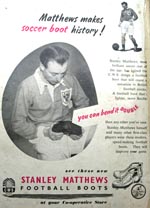 I have just finished the cataloguing of all 274 issues so that you can now search that period of football history by individual player, team or event on the website. I also took the opportunity of noting the advertisers as they appeared in magazine over the 23 years. Many types of advertisers took advantage of the enormous market share the magazine could give but in this article I am going to focus on football boots.
I have just finished the cataloguing of all 274 issues so that you can now search that period of football history by individual player, team or event on the website. I also took the opportunity of noting the advertisers as they appeared in magazine over the 23 years. Many types of advertisers took advantage of the enormous market share the magazine could give but in this article I am going to focus on football boots.The back page of issue number one in 1951 was dedicated to a personal endorsement (right) for football boots from the superstar of the day. Stanley Matthews had helped the Co-op design a football boot that was apparently lighter and more flexible than any seen before.
Headlam-Sims
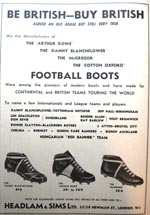 The truth was that football boots had not changed very much since the early 1900s, they still covered your ankles, and protection was the most important design factor (no one broke their metatarsals in those days!). Changes had centred on the addition of removable studs, and differences in the materials that boots were made of, meaning more synthetics and rubber and less leather and steel.
The truth was that football boots had not changed very much since the early 1900s, they still covered your ankles, and protection was the most important design factor (no one broke their metatarsals in those days!). Changes had centred on the addition of removable studs, and differences in the materials that boots were made of, meaning more synthetics and rubber and less leather and steel.Gola are the oldest remaining manufacturer who started making boots in 1905 but it is Adolf and Rudolf Dassler who will eventually steal the show, and they started making boots with replaceable nail studs in 1924. The brothers were to fall out in 1948 and Adolf (Adi) formed Adidas and Rudolf started Puma (not Rudidas as you might suspect!).
But as you can see from this August 1957 Headlam and Sims Ltd advert football boots still looked like they had always done.
Headlam and Sims Ltd still used the old and tried formula of celebrity endorsement with Blanchfower, Shackleton and Revie amongst the many that were willing to put their names to the advert. However, what is interesting is the headline asking for the customer to "Be British and Buy British".
Manfield -Hotspur
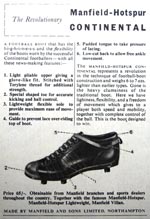
Ever since Hungary had beaten England 7-1 at Wembley in 1953 there had been persistent rumblings for a change to "continental" systems, and this also entailed a desire for a more responsive football shoe, rather than a boot so that English players could magically play in the same manner.
This new style was epitomised by the "Manfield-Hotspur Continental" that appeared in the same August 1957 edition (right).
65/- bought you these boots that do look much more like today's modern boot; gone was the "heavy clumsiness of the old boot".
Charlton, Pele, Puma, Adidas
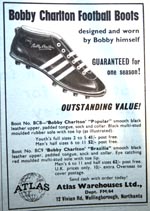 | 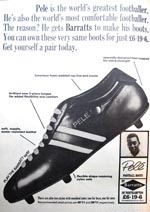 | 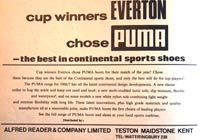 |  | |||
| Bobby Charlton | Pele | Everton | Adidas |
This style was here to stay as was player endorsement and the next generation's superstar was Bobby Charlton. October 1964 issue (above, far left).
By the July 1966 issue, football boots advertisers had their ultimate player, and Pele decided to endorse Barratts football boots (above, near left).
Presumably this was for the money, as Pele was more famous for wearing Puma boots, as did Everton in 1966 (above, near right).
However the winning manufacturer at the 1966 World Cup finals with 75% of the players wearing his boots was Adi Dassler. In fact 20 players in the final between England and West Germany wore them (above, far right).
Stylo, Mitre, Cheetah
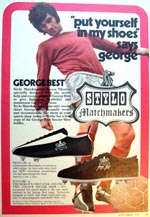 | 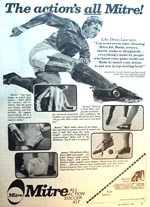 | 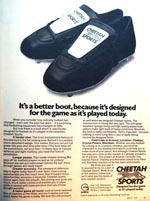 | ||
| Stylo | Mitre | Cheetah |
In the period until the demise of the Charles Buchan's Football Monthly in 1974, it would be Adidas that would remain all powerful, with Puma in second place. Other manufacturers came along in the 1960s, such as Mitre (1960), Joma (1965) and Asics (1964).
The 1970s featured other British advertisers trying to shoe horn their way into the market and Stylo Matchmakers (above left) were the football shoe that I yearned for most, probably because George Best told me (September 1974 issue) that they were his preferred footwear, even though Denis Law wore Mitre (above centre).
By July 1971 competing manufacturers were trying to beat Adidas and Puma with a scientific and futuristic approach, probably best illustrated by those boffins at Cheetah Sports (above right).
For more information:
info@CharlesBuchansFootballMonthly.com
01202 259155







